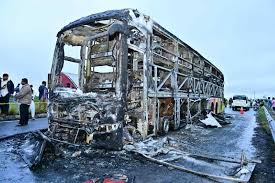Sleeping deathtraps: On the Kurnool sleeper bus fire
Modifications at body shops make sleeper buses vulnerable.
The accident in Kurnool district, Andhra Pradesh, in the early hours of October 24, 2025, involving a “luxury” bus from Hyderabad to Bengaluru with 46 passengers, was one that mirrored previous such tragedies. It was apparently triggered by a fuel leak after the bus collided with a bike that had been knocked to the ground earlier in a hit-and-run incident. The accident claimed 20 lives including the bike rider; the survivors barely managed to escape through broken windows. Some 10 days earlier, 20 people were burnt alive when an air-conditioned bus from Jaisalmer to Jodhpur, with 57 passengers, caught fire. There have been several eerily similar fires such as in 2023, on a Nagpur-Mumbai bus.
Typically, most of these buses carry the names of well-known brands but the fact is that only the engine and the chassis are purchased from these OEMs. The chassis is then made into a full bus in body-building shops. While there is a case that increasingly advanced electronics, electrical and the air-conditioning systems used carry the risk of electric fires, rigorous safety standards are typically followed while designing and installing these systems. But what is not rigorous is body installation and modifications made at the body shops. The Automotive Industry Standards (AIS) developed by the Road Transport Ministry do lay down the structural and fire safety requirements for bodies as well, but these are seldom followed. Often, the body is made of poor quality composite material that is highly inflammable. There is hardly any crash testing. At the body shop, unsafe modifications are sometimes made such as installing an extra fuel tank. The sleeper arrangements on board restrict passenger movement. Soft, highly inflammable materials are used for curtains and other barricades. Recent regulations specify that there must be four exits on such buses — two main doors and two collapsible windows — with no seat or sleeper obstructing them. But these do not apply to the existing fleet. The drivers are often not trained to handle emergencies. It would enhance safety to mandate that the emergency exit arrangements are explained to passengers as they are on a flight. Crash testing of the entire bus assembly must be mandated to enhance safety during collisions. Though current standards mandate fire detection and safety systems that would detect and give audible and visual warnings in a fire followed by the activation of firefighting devices, these are seldom followed at the body shops. What is needed is a more comprehensive AIS that takes into account risks in sleeper buses followed by strict implementation and regular monitoring.
